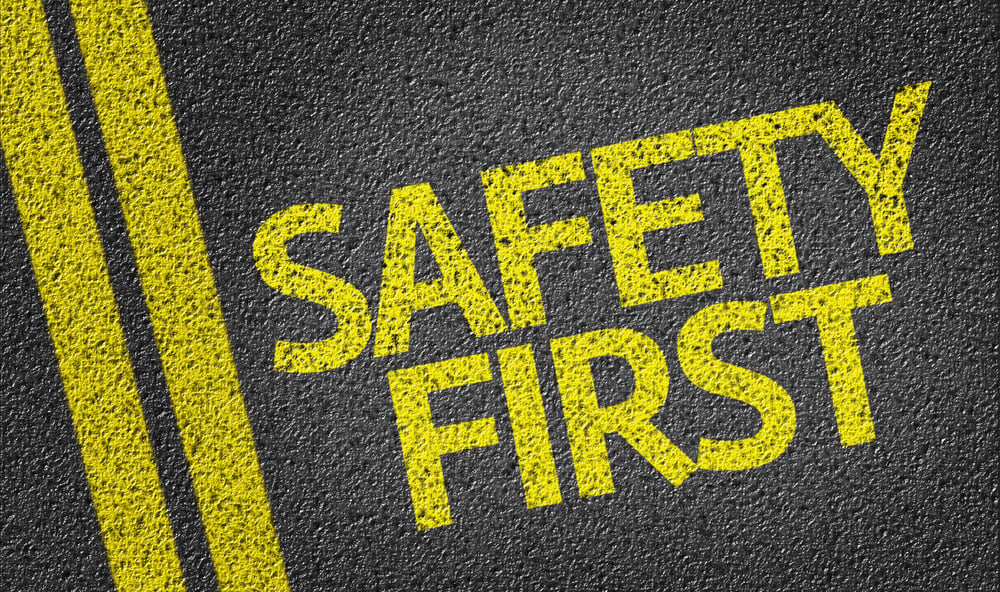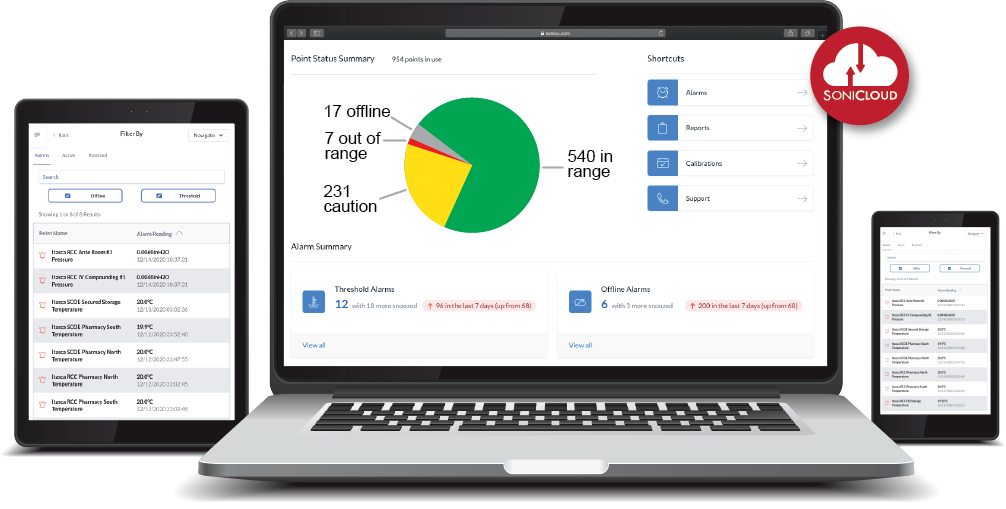
Identifying Open Door Threats in the OR to Reduce Surgical Site Infections
Operating rooms may be among the most tightly regulated environments in healthcare facilities, Sonicy helps ensure they're safe and monitored correctly.
Designed with safety, efficiency and compliance always top of mind, we’ve evolved over a decade with continuous improvements from customer feedback. Serving the healthcare, research and food service industries.
Sonicu offers a comprehensive suite of monitoring solutions
that help organizations safeguard assets, automate compliance and reduce manual processes.
Sonicu offers a comprehensive suite of monitoring solutions
that help organizations safeguard assets, automate compliance and reduce manual processes.
From protecting vaccines and research materials to safeguarding food service and facility operations, Sonicu’s monitoring applications cover temperature, humidity, pressure, and more. Whether you’re in healthcare, life sciences, food safety, or other industries, Sonicu provides visibility, compliance, and peace of mind across all your critical applications.

Understanding Heat Stress and OSHA Regulations: How to Protect Your Employees and Ensure Compliance

Employers nationwide should take note of the new messages and warnings put forth by the Occupational Safety and Health Administration regarding heat stress and related illness.
“Water. Rest. Shade.”
These practices can be the difference between ending the workday safely or having to take care of serious, life-threatening injuries.
Employers are encouraged to complete the following actions to prevent the effects of heat-related injuries and illnesses on their worksites:
The effects of heat-related illness vary on an individual basis.
Heat dissipation, the body's natural ability to shed excess heat through sweat, is what’s needed to maintain a healthy internal body temperature.
However, if heat dissipation does not happen quickly enough, which is often the result of dehydration and lack of proper acclimatization, the internal body temperature will keep rising to dangerous levels without intervention.
Types of Heat-Related Illnesses: Exertional vs. Environmental
Exertional heat illness is the kind that comes from exertion, being the metabolic heat that’s generated by heavy muscle use and activity in the body. Since this type of illness depends on the individual's metabolism and acclimation to high temperatures, this is the most dangerous as it is dependent on the particular person.
If the individual has a slow metabolism or a pre-existing condition that makes them susceptible to heat, they have a higher risk of suffering from heat-related illness.
This type of heat illness even depends on body mass index, and people with higher BMI or other genetic conditions that make the body more vulnerable to heat are also at increased risk for heat-related illness.
The other type of heat-related illness is environmental.
This type of illness comes from ambient conditions with high heat and relative humidity. This type of heat illness can occur anywhere, as it involves heat waves, urban heat islands, and even hot motor vehicles.
This is the easiest heat-related illness to avoid, as paying attention to weather alerts and proper cooling systems can lower the risks of environmental heat illness.
Both illnesses combined are dangerous, but when solutions to each are considered and united, it is easier to cool workers down more rapidly. A way to combine both of these is by ensuring there are proper cooling methods, including shade and air conditioning, as well as proper hydration and heat acclimation.
When combined, the prevention of heat-related illnesses in the workplace is diminished.

How to Combat Heat Stress Illness
A way for employers to prevent heat-related illness is by having an active managerial commitment to providing the most effective controls and strategies.
OSHA recommends several practices for safety and health programs, including engineering controls, changes to workloads and schedules, and proper training to recognize symptoms of heat-related illness and first aid.
OSHA recommended changes to workload and schedules that empower all workers to slow down physical activity.
This can be done through the reduction of manual handling speeds, scheduling work for the morning when the heat index is at its lowest, shorter shifts with frequent rest breaks away from heat, proper hydration, and proper training.
Proper training is the most vital of these recommended practices, as collaborative efforts are key to preventing heat-related illnesses. Knowing the symptoms and moving quickly to reduce its effects is the difference between making it home from a shift and a potentially fatal outcome at the job site.
Proper first aid for heat-related illness is to cool the affected worker. Cooling techniques such as ice or cold towels on areas that produce the highest amount of sweat, being the head, neck, trunk, armpits, and groin, and immersing the worker in cold water or an ice bath are the best techniques.
Combining these techniques with cool air and staying with them until the symptoms decrease are proper first aid principles.
The best principle for management to reduce heat-related illness is accurate heat measurement.
Besides a thermometer, OSHA recommends the use of an on-site wet bulb globe temperature to measure the impact of environmental heat on body temperature. Sonicu also offers heat stress monitoring that is more precise, cloud-based, and has mobile alerts via text and phone calls to alert managers when heat stress levels are dangerous.
OSHA provides the example of the WBGT meter as it incorporates temperature, humidity, sunlight, and air movement into a single measurement.
OSHA also recommends the use of heat calculator apps, the NIOSH/OSHA Heat App, which is available on any iOS or Android device.
These apps are simple to heat calculators that only provide the heat index for the specific user’s location and workload guidance, and occupational safety and health recommendations for hot conditions.
In the words of OSHA, “Employers must protect workers from the dangers of heat illness in hot indoor and outdoor environments,” William Donovan, OSHA’s Chicago regional administrator, said in an agency statement (Burdick et al.).

What Employers Can Do
Employers can heed these words by investing in better monitoring platforms, such as Sonicu’s software dashboard.
Dashboards contain a customizable view of the monitoring points in your facility. The dashboard helps provide a visual indicator of real-time conditions in your facility through color coordination. Individual points can show custom time frames and be downloaded into various graph formats.
All of the information on the dashboards includes links to calibration certificates that meet OSHA monitoring standards.

One of the most powerful features of the Sonicu dashboard is the ability to create and customize SoniCloud Reports.
Reports on the platform are designed to easily track point data, alarms, and temperature thresholds. Reports can be pulled anytime, and data logs are designed to help Sonicu clients achieve regulatory compliance.
The most essential report to achieve proper OSHA-recommended practices that prevent heat stress is the Threshold Achievement Report.
This report allows clients to view threshold compliance for each monitoring point and quickly pinpoint specific equipment that does not maintain the desired threshold.
This information can save lives as it easily identifies areas that need improvement without the need for OSHA officers to cite you for violations and critiques for the same thing.
Further information and a tutorial on SoniCloud reports are linked here.
Take the first step towards protecting your business and employers by scheduling a demo with Sonicu here today!
Sources:
“Alarms and Notifications.” YouTube, YouTube, 21 Mar. 2022, www.youtube.com/watch?v=0ck9TceccuM.
Coffman, Jackie, et al. “OSHA Issues ANPRM on Heat Injury and Illness Prevention.” JD Supra, www.jdsupra.com/legalnews/osha-issues-anprm-on-heat-injury-and-8154517/.
Heat Injury and Illness Prevention in Outdoor and Indoor Work Settings Rulemaking | Occupational Safety and Health Administration, www.osha.gov/heat-exposure/rulemaking.
Tenn, Ashlee. “Cooling Solutions Feature: OSHA, Heat Exposure, and Worker Safety.” Facility Executive, 27 June 2022, https://facilityexecutive.com/2022/06/cooling-solutions-feature-osha-heat-exposure-worker-safety/
Subscribe to our newsletter for expert insights, product updates, and strategies to keep your operations running smoothly.

